.

.
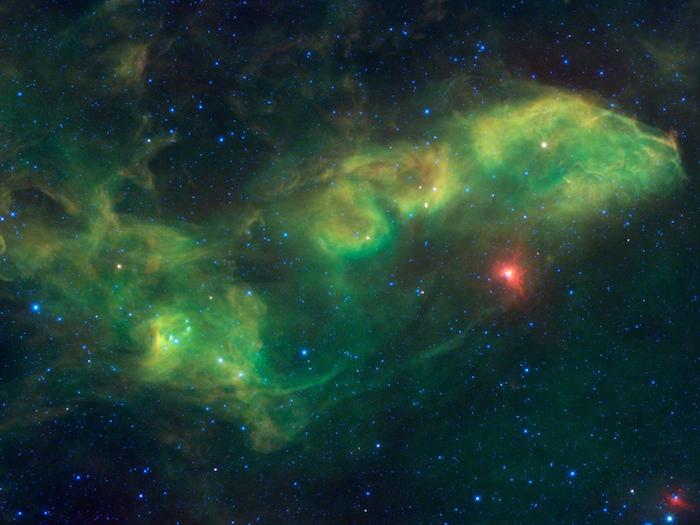
Jabbah and Associates
No, it's not a gang of intergalactic mobsters from the famous Star Wars movies. Jabbah is the name of the bright star right of center, surrounded by a red colored dust cloud. The Arabic name means "the forehead of the scorpion." This view from NASA's Wide-field Infrared Survey Explorer, or WISE, takes in an area of the sky in the constellation of Scorpius surrounding Jabbah, which is larger than a grid of eight by eight full moons. Though Jabbah appears to be a single star, it is actually a whole system of stars (possibly as many as seven), each of which is many times more massive, larger, hotter and more luminous than the sun. The Jabbah system is located about 440 light-years away from us and lights up a giant cloud of dust and gas near it. The cloud near Jabbah is designated IC 4592, and the portion farthest away to the far left in the image is IC 4601.The other bright stars in this image are mostly part of the "Upper Scorpius Association" and were probably once all born in the same cluster about 5 million years ago. These stars are all moving apart as the cluster ages, and are probably no longer bound to each other by gravity.Another star of interest in the image is 9 Scorpii, located in the lower right corner with the bright red dust cloud primarily on one side of it. 9 Scorpii is another very massive star that is probably a member of the Upper Scorpius Association. It is also moving through space at an enormous speed of 1,000 kilometers per second (224,000 miles per hour). With such a speed, the star may be a runaway star once in a system with a more massive member that exploded as a supernova and sent 9 Scorpii zooming through space. The red cloud near it may be a bow shock in front of it similar to the stars called Alpha Cam and Zeta Oph.
This image was made from observations by all four infrared detectors aboard WISE. Blue and cyan (blue-green) represent infrared light at wavelengths of 3.4 and 4.6 microns, which is primarily from stars, the hottest objects pictured. Green and red represent light at 12 and 22 microns, which is primarily from warm dust.
.
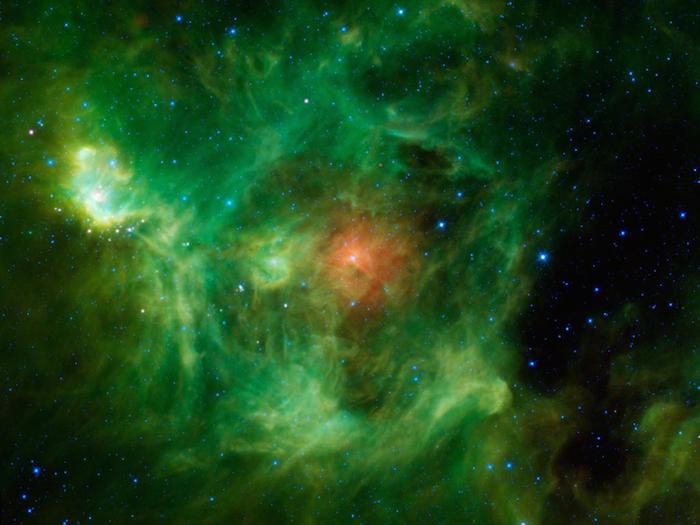
A Cosmic Wreath
NASA's Wide-field Infrared Survey Explorer (WISE) mission presents the "Wreath nebula." Though this isn't the nebula's official name (it's actually called Barnard 3, or IRAS Ring G159.6-18.5), one might picture a wreath in these bright green and red dust clouds -- a ring of evergreens donned with a festive red bow, a jaunty sprig of holly, and silver bells throughout. Interstellar clouds like these are stellar nurseries, places where baby stars are being born.
The green ring (evergreen) is made of tiny particles of warm dust whose composition is very similar to smog found here on Earth. The red cloud (bow) in the middle is probably made of dust that is more metallic and cooler than the surrounding regions. The bright star in the middle of the red cloud, called HD 278942, is so luminous that it is likely what is causing most of the surrounding ring to glow. In fact its powerful stellar winds are what cleared out the surrounding warm dust and created the ring-shaped feature in the first place. The bright greenish-yellow region left of center (holly) is similar to the ring, though more dense. The bluish-white stars (silver bells) scattered throughout are stars located both in front of, and behind, the nebula.
Regions similar to this nebula are found near the band of the Milky Way galaxy in the night sky. The "wreath" is slightly off this band, near the boundary between the constellations of Perseus and Taurus, but at a relatively close distance of only about 1,000 light-years, the cloud is a still part of our Milky Way.
The colors used in this image represent specific wavelengths of infrared light. Blue and cyan (blue-green) represent light emitted at wavelengths of 3.4 and 4.6 microns, which is predominantly from stars. Green and red represent light from 12 and 22 microns, respectively, which is mostly emitted by dust.
.
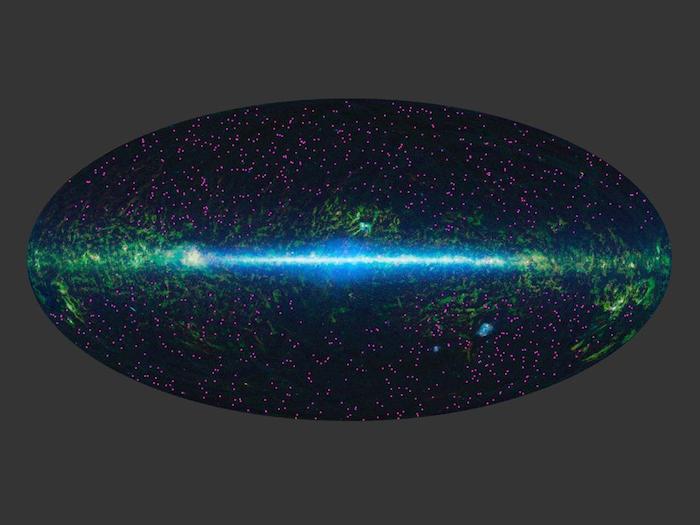
Galaxies Burn Bright Like High-Wattage 'Light Bulbs'
NASA's Wide-field Infrared Survey Explorer (WISE) has identified about 1,000 extremely obscured objects over the sky, as marked by the magenta symbols. These hot dust-obscured galaxies, or "hot DOGs," are turning out to be among the most luminous, or intrinsically bright objects known, in some cases putting out over 1,000 times more energy than our Milky Way galaxy.
.
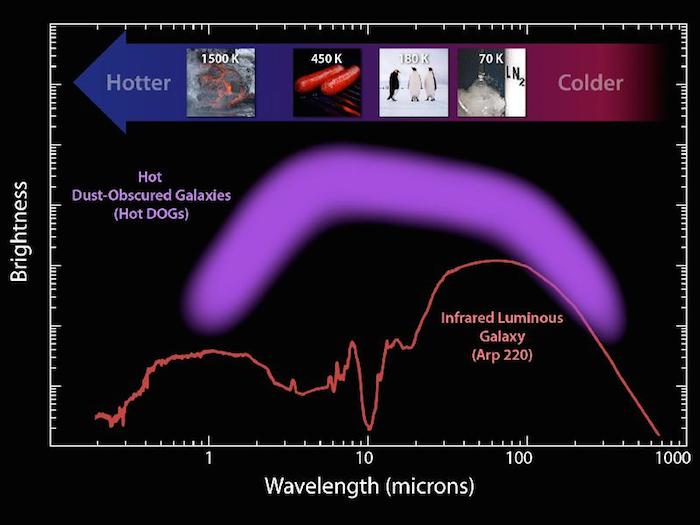
Analyzing Hot DOG Galaxies
This plot illustrates the new population of "hot DOGs," or hot dust-obscured objects, found by WISE. The purple band represents the range of brightness observed for the extremely dusty objects. These powerful galaxies, which host active supermassive black holes at their cores, pour out enormous amounts of light at infrared wavelengths, while their visible light is blocked by dust.
Visible light we see with our eyes has shorter wavelengths than one micron, while the longest wavelengths shown here come from observations with the Caltech Submillimeter Observatory on Mauna Kea, Hawaii. The red line shows the brightness profile, or spectral energy distribution, of a proto-typical infrared luminous galaxy.
The small images near the top show more familiar objects at a range of temperatures from 70 Kelvin, or minus 330 degrees Fahrenheit, for liquid nitrogen, to 1,500 Kelvin, or 2,240 degrees Fahrenheit, for lava. The energy from hotter objects peaks at shorter wavelengths.
The extreme WISE objects represented by the purple band are much brighter -- and peak at much shorter, or hotter, wavelengths -- than the typical infrared luminous galaxy, hence their nickname: hot dust-obscured galaxies, or Hot DOGs.
.
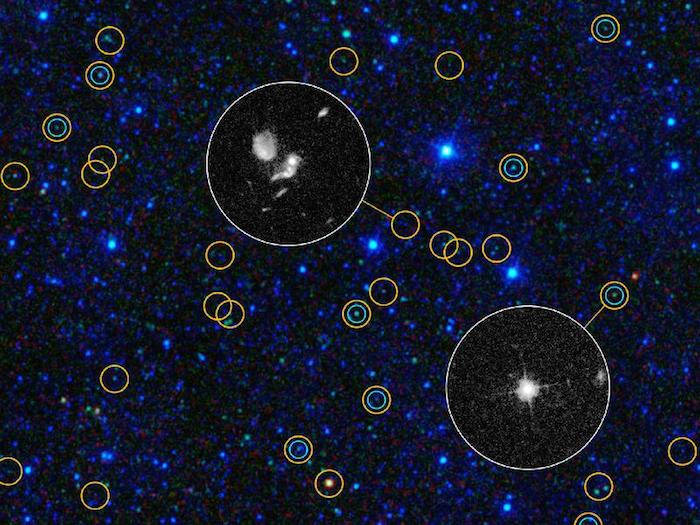
Exposing Black Holes Disguised in Dust
This zoomed-in view of a portion of the all-sky survey from NASA's Wide-field Infrared Survey Explorer shows a collection of quasar candidates. Quasars are supermassive black holes feeding off gas and dust. The larger yellow circles show WISE quasar candidates; the smaller blue-green circles show quasars found in the previous visible-light Sloan Digital Sky Survey. WISE finds three times as many quasar candidates with a comparable brightness. Thanks to WISE's infrared vision, it picks up previously known bright quasars as well as large numbers of hidden, dusty quasars.
The circular inset images, obtained with NASA's Hubble Space Telescope, show how the new WISE quasars differ from the quasars identified in visible light. Quasars selected in visible light look like stars, as shown in the lower right inset; the cross is a diffraction pattern caused by the bright point source of light. Quasars found by WISE often have more complex appearances, as seen in the Hubble inset near the center. This is because the quasars found by WISE are often obscured or hidden by dust, which blocks their visible light and allows the fainter host galaxy surrounding the black hole to be seen.
.
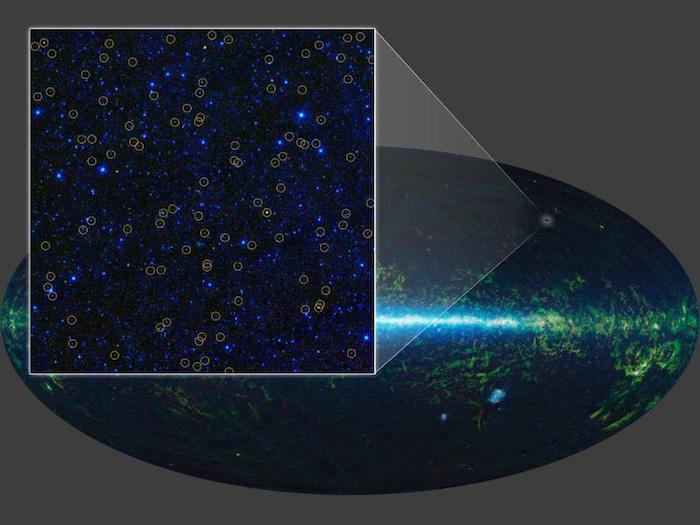
A Sky Chock-Full of Black Holes
With its all-sky infrared survey, NASA's Wide-field Infrared Survey Explorer, or WISE, has identified millions of quasar candidates. Quasars are supermassive black holes with masses millions to billions times greater than our sun. The black holes "feed" off surrounding gas and dust, pulling the material onto them. As the material falls in on the black hole, it becomes extremely hot and extremely bright. This image zooms in on one small region of the WISE sky, covering an area about three times larger than the moon. The WISE quasar candidates are highlighted with yellow circles.
Image credit: NASA/JPL-Caltech/UCLA
.
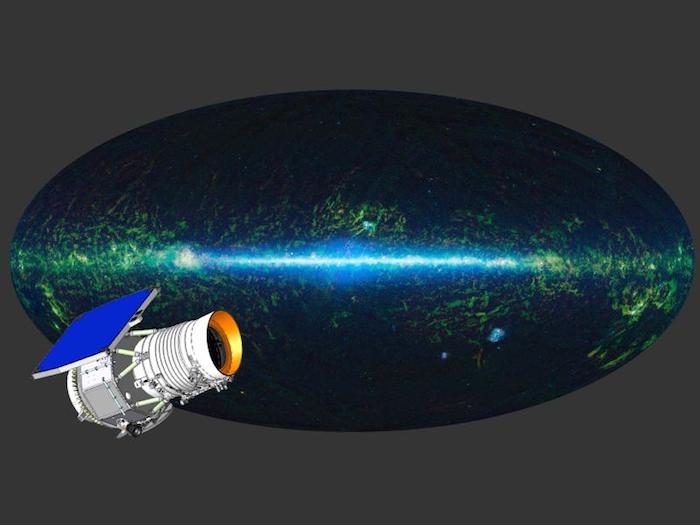
A WISE 'Eye' on the Whole Sky
The entire sky as mapped by WISE at infrared wavelengths is shown here, with an artist's concept of the WISE satellite superimposed.
Image credit: NASA/JPL-Caltech/UCLA
.
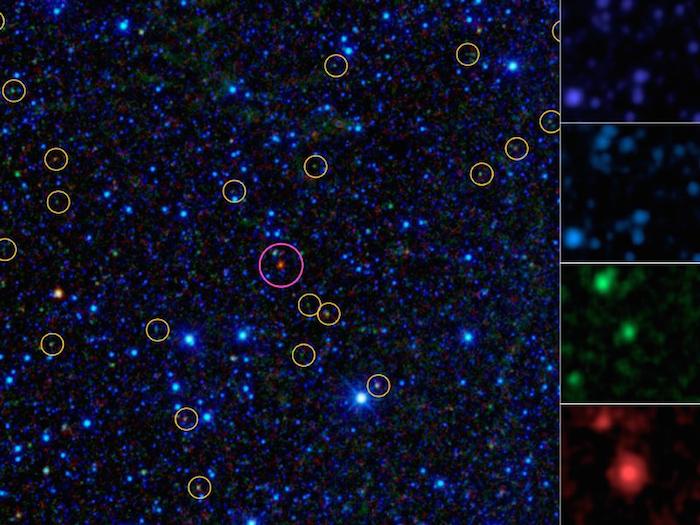
Homing in on 'Hot Dogs'
This image is a portion of the all-sky survey from NASA's Wide-field Infrared Survey Explorer, or WISE. It highlights the first of about 1,000 "hot DOGs" found by the mission (magenta circle). Hot DOGs are hot dust-obscured galaxies and are among the most powerful galaxies known. Yellow circles are active supermassive black holes found by WISE, which are much more common.
The panels at right show the "Hot DOG" as seen in the four individual infrared bands obtained by WISE. These images are at wavelengths from 5 to 30 times redder than what our eyes can see, with the shortest wavelengths at top, and longest at bottom.
Dust affects shorter wavelengths more than longer wavelengths. These objects are so dusty that not only their visible light but also their shorter-wavelength infrared light is blocked, as evident by their apparent absence in the top two panels. Less than one in 100,000 WISE sources are similarly prominent only in the two longer-wavelength WISE infrared bands.
Image credit: NASA/JPL-Caltech/UCLA
.
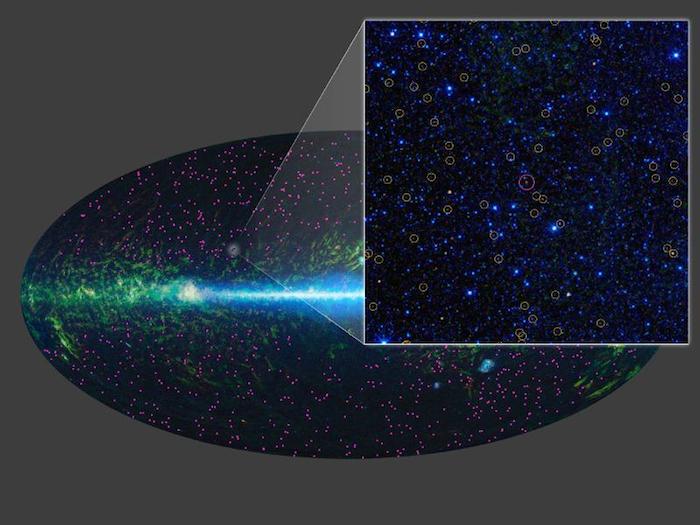
Extremely Bright and Extremely Rare
This image zooms in on the region around the first "hot DOG" (red object in magenta circle), discovered by NASA's Wide-field Infrared Survey Explorer, or WISE. Hot DOGs are hot dust-obscured galaxies. Follow-up observations with the W.M. Keck Observatory on Mauna Kea, Hawaii, show this source is over 10 billion light-years away. It puts out at least 37 trillion times as much energy as the sun.
WISE has identified 1,000 similar candidate objects over the entire sky (magenta dots). These extremely dusty, brilliant objects are much more rare than the millions of active supermassive black holes also found by WISE (yellow circles).
Image credit: NASA/JPL-Caltech/UCLA
.
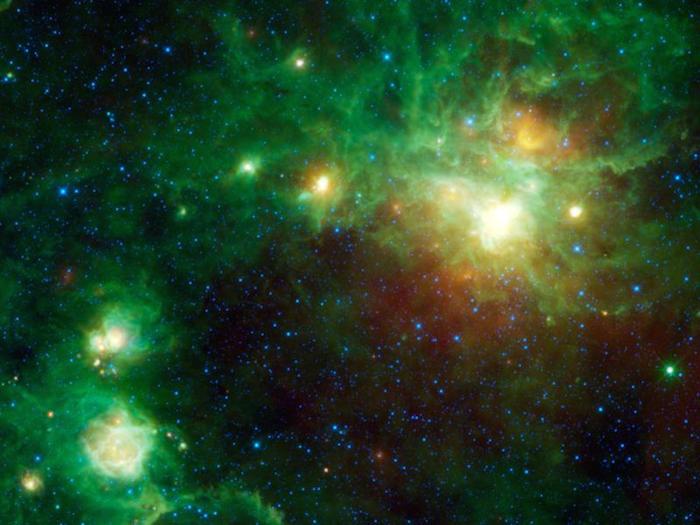
Star Formation Everywhere You Look
This image from NASA's Wide-field Infrared Survey Explorer, or WISE, highlights several star-forming regions. There are five distinct centers of star birth in this one image alone. Star-forming nebulae (called HII regions by astronomers) are clouds of gas and dust that have been heated up by nearby stars recently formed from the same cloud.
The largest, brightest cloud, in the upper right is known as Gum 22. It's named after Colin Gum, an Australian astronomer who surveyed the southern hemisphere sky in the early 1950's looking for star-forming regions like these. He catalogued 85 new such regions, named Gum 1 to85 (Gum Crater on the moon was also named in his honor).
Going counter-clockwise from Gum 22, the other catalogued nebulae in the image are Gum 23 (part of same cloud as 22), IRAS 09002-4732 (orange cloud near center), Bran 226 (upper cloud of the two at lower left), and finally Gum 25 at far lower left. There are also several smaller and/or more distant regions scattered throughout the image that have yet to be catalogued. Most of the regions are thought to be part of our local Orion spiral arm spur in the Milky Way galaxy. Their distances range from about 4,000 to 10,000 light-years away.
Notice the very bright green star near the lower right portion of the image. You can tell it's a star because it appears to have 'spikes' sticking out of it (diffraction spikes like these are an optical effect caused by the structure of the telescope). Bright stars in WISE images are typically blue, so you know this one is special. Known as IRAS 08535-4724, it's a unique type of stellar giant called a carbon star. Carbon stars are similar to red giants stars, which are much larger than the sun, glow brightly in longer wavelengths, and are in the late stages of their lives. But they have unusually high amounts of carbon in their outer atmospheres. Astronomers think this carbon comes either from convection currents deep within a star's core, or from a nearby neighboring star, from which it is siphoned. Recent evidence suggests that a carbon star like this one will end its life in an extremely powerful explosion called a gamma-ray burst, briefly outshining the sun a million trillion times.
The colors used in this image represent specific wavelengths of infrared light. Blue and cyan (blue-green) represent light emitted at wavelengths of 3.4 and 4.6 microns, which is predominantly from stars. Green and red represent light of 12 and 22 microns, respectively, which is mostly emitted by dust.
Image credit: NASA/JPL-Caltech/UCLA
.
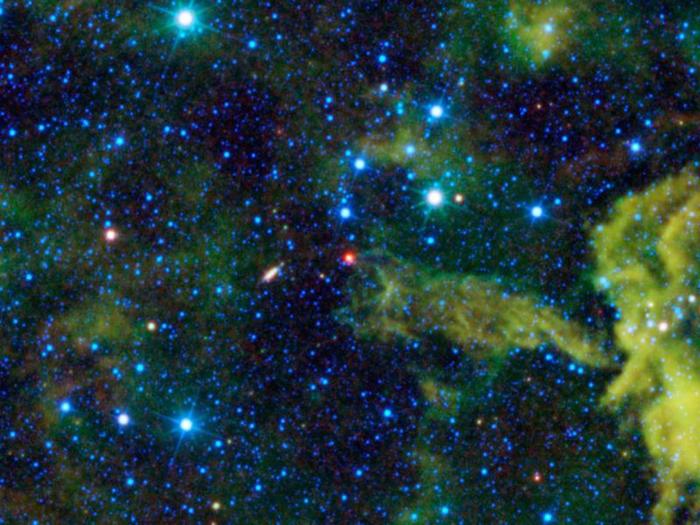
Cosmic Alligator Eats its Way Through the Sky
Many people enjoy the summer pastime of imagining pictures in clouds in the sky. The same can be done with clouds in the universe. Seen here by NASA's Wide-field Infrared Survey Explorer, or WISE, the cloud CG4 might be imagined as a cosmic alligator eating its way across the sky. Others might see a giant red-nosed slug. The open jaws of the alligator appear poised to chomp down on a red star. This red source is the young stellar object, called Spitzer 073425.3-465409. Young stellar objects are exactly what they sound like: stars that are in their early stages of formation. The reddish color of this star is due to its surrounding dust that glows in infrared light.A little further towards the left lies a galaxy that will make a nice dessert for the alligator (or slug). The galaxy is ESO 257-19, a spiral galaxy that appears elongated because it is inclined to our field of view. At approximately 118,000,000 light-years distant, ESO 257-19 is extremely far away. By comparison, CG4 and Spitzer 073425.3-465409 are 1,300 light-years distant, placing them both well within the bounds of the Milky Way Galaxy.The letters CG in CG4 stand for cometary globule. Despite its name, a cometary globule is not a comet. Comets are icy chunks of frozen gases with embedded rock and dust that orbit around the sun. Cometary globules resemble comets in shape in that they appear to have an opaque "head" and a luminous "tail," but have a vastly different scale than comets. Rather than being a densely packed "snowball" with a tail millions of miles long, CG4 is actually a cloud of gas and dust trillions of miles across. The gas in this cloud is heated by nearby young, hot massive stars, causing it to glow in infrared light.
Color in this image represents specific wavelengths of infrared light. Blue and cyan represent light emitted at 3.4 and 4.6 microns, primarily from hot stars. Green and red represent light emitted at 12 and 22 microns, primarily from clouds of dust.
.

Searching for the Origins of the Dinosaur-Killing Asteroid
Scientists think that a giant asteroid, which broke up long ago in the main asteroid belt between Mars and Jupiter, eventually made its way to Earth and led to the extinction of the dinosaurs. Data from NASA's WISE mission likely rules out the leading suspect, a member of a family of asteroids called Baptistina, so the search for the origins of the dinosaur-killing asteroid goes on.
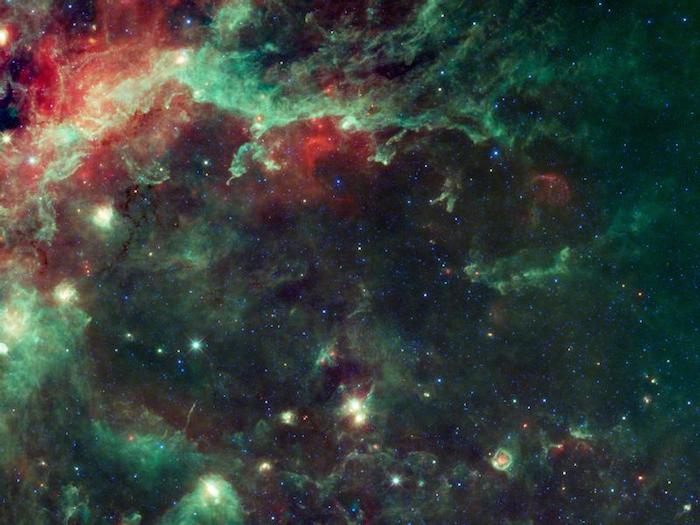
Star Formation in the Heart of the Swan
NASA's Wide-field Infrared Survey Explorer, or WISE, captured this image of a huge complex of star-forming clouds and stellar clusters found in the constellation Cygnus. Best known as a swan winging its way across the night, the constellation Cygnus is easily seen in the northern hemisphere's summertime sky. The constellation is also commonly known as the Northern Cross. WISE zooms in on the region surrounding the swan's heart, revealing vast clouds of dust that light up the sky in infrared. This image covers an area of the sky nearly ten times as wide as the full moon and nearly nine times as high (4.93 by 4.47 degrees).
The heart of the swan (or the center of the cross) is represented by the star Sadr, seen here as the bright yellow spot near the point where the green filaments in the upper part of the image converge and bend down towards the left . This star's name comes from the Arabic phrase "Al Sadr al Dajājah," meaning the Hen's Breast. Sadr is also known as Gamma Cygni because it is the third brightest star in the constellation Cygnus. Although Sadr is very bright in visible light, in infrared light it is overshadowed by surrounding clouds of dust and gas, including the nebulae IC 1318, LDN 889 and NGC 6888. Although it looks like Sadr is embedded in the nebulae, it is actually only 1,800 light years away whereas the nebula IC 1318 is much more distant at 4,900 light-years.
IC 1318 can be seen as the bright green and red clouds that curve to the left of Sadr. There are three distinct parts of this nebula that are identified as IC 1318 A, B and C. This nebula is considered an emission nebula because radiation from nearby stars heats the cloud, causing it to become ionized and emit visible light.
When viewed through optical telescopes, a black rift separates IC 1318 B and C. This dark area is known as LDN 889 and is classified as a dark nebula. In visible light, this cloud of dust obscures light from the stars behind it, making it appear as though there is a dark lane cutting through the sky. WISE detects this dust in infrared light so we can see it. LDN stand for Lynds' Dark Nebula, which is a catalogue of dark nebula complied by astronomer B.T. Lynds.
On the opposite side of the WISE image, in the upper right quadrant, we can see a curved red cloud. This is another nebula, NGC 6888. More descriptively known as the Crescent nebula, this is another emission nebula. This nebula is ionized by a very hot, very massive type of star known as a Wolf-Rayet star, WR 136.
Scattered throughout this image are numerous stellar clusters of varying ages. One example is the star cluster Messier 29, which can be found to the left of center in the WISE image. Also known as M29 or NGC 6913, this is an open cluster of stars located approximately 3,700 light-years away.
Image Credit: NASA/JPL-Caltech/UCLA
.
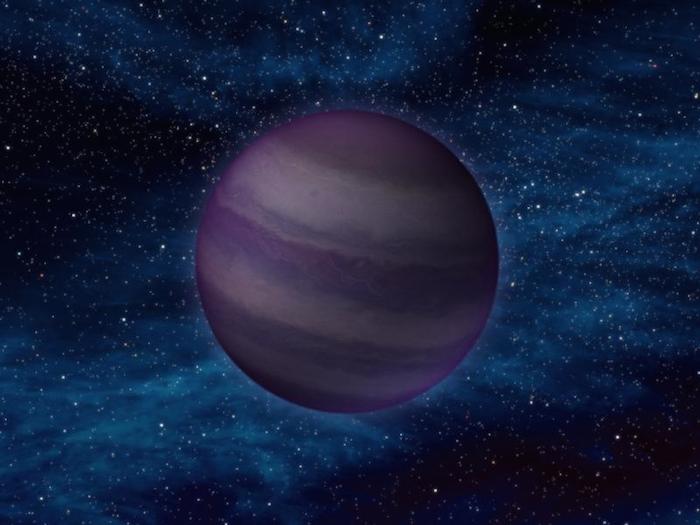
'Y Dwarf' Chillin' in Space
This artist's conception illustrates what a "Y dwarf" might look like. Y dwarfs are the coldest star-like bodies known, with temperatures that can be even cooler than the human body. NASA's Wide-field Infrared Survey Explorer uncovered these elusive objects for the first time, using its heat-sensing, infrared vision. The telescope found six Y dwarfs, ranging in atmospheric temperatures from 350 degrees Fahrenheit (175 degrees Celsius) to less than about 80 degrees Fahrenheit (25 degrees Celsius).
Y dwarfs belong to a larger family of objects called brown dwarfs. Brown dwarfs begin their lives like stars but they never accumulate enough mass to fuse atoms steadily at their cores and shine with starlight -- as our sun does so well. Instead, they fade and cool with time, giving off most of their light in infrared wavelengths.
WISE was able to pick up this faint glow for six Y dwarfs, which are the coldest class of brown dwarfs and the latest letter in the stellar classification scheme. This scheme describes stars of all temperatures, beginning with the hottest "O" stars and now ending with the coldest Y dwarfs. The entire scheme includes the classes: O, B, A, F, G, K, M, L, T, Y. Our yellow sun belongs to the G class of stars. M stars are colder than our sun, and reddish in color.
While the O through K classes are all considered stars, M and L objects are a mixture of stars and brown dwarfs, and T and Y objects are all brown dwarfs. The term "brown dwarfs" was chosen because at that time, astronomers didn't know what colors these objects would actually have at the visible wavelengths our eyes see, and brown is not a true color of light (there are no "brown photons"). Astronomers now know that T dwarfs would appear reddish, or magenta, to the eye. But they are not certain what color Y dwarfs are, since these objects have not been detected at visible wavelengths. The purple color shown here was chosen mainly for artistic reasons. In addition, the Y dwarf is illustrated as reflecting a faint amount of visible starlight from interstellar space.
Image credit: NASA/JPL-Caltech
.
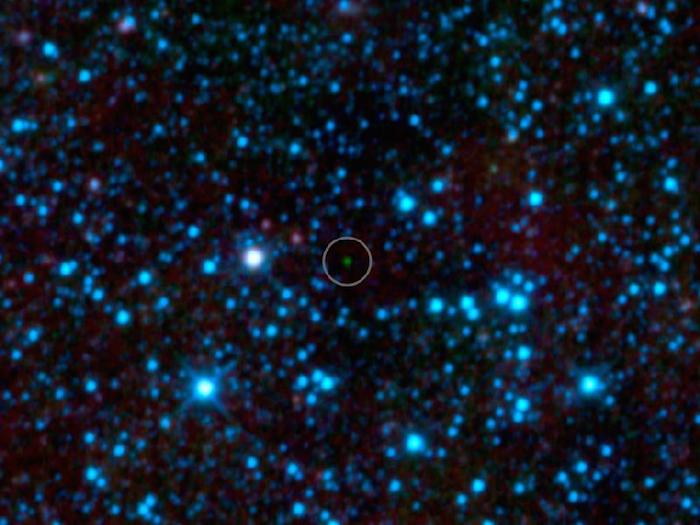
Reigning Title-Holder for Coldest Brown Dwarf
NASA's Wide-field Infrared Survey Explorer, or WISE, has uncovered the coldest brown dwarf known so far (green dot in very center of this infrared image). Called WISE 1828+2650, this chilly star-like body isn't even as warm as a human body, at less than about 80 degrees Fahrenheit (25 degrees Celsius). Like other brown dwarfs, it began life like a star, collapsing under its own weight into a dense ball of gas. But, unlike a star, it didn't have enough mass to fuse atoms at its core, and shine steadily with starlight. Instead, it has continued to cool and fade since its birth, and now gives off only a feeble amount of infrared light. WISE's highly sensitive infrared detectors were able to catch the glow of this object during its all-sky scan, which lasted from Jan. 2010 to Feb. 2011.
WISE 1828+2650 is located in the constellation Lyra. The blue dots are a mix of stars and galaxies.
This view shows three of WISE's four infrared channels, color-coded blue, green and red, with blue showing the shortest infrared wavelengths and red, the longest.
Image credit: NASA/JPL-Caltech/UCLA
.
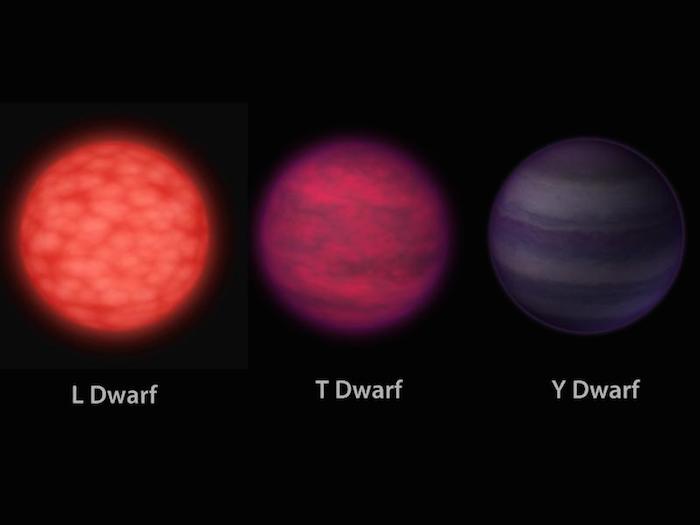
A Trio of Brown Dwarfs
This artist's conception illustrates what brown dwarfs of different types might look like to a hypothetical interstellar traveler who has flown a spaceship to each one. Brown dwarfs are like stars, but they aren't massive enough to fuse atoms steadily and shine with starlight -- as our sun does so well.
On the left is an L dwarf, in the middle is a T dwarf, and on the right is a Y dwarf. The objects are progressively cooler in atmospheric temperatures as you move from left to right. Y dwarfs are the newest and coldest class of brown dwarfs and were discovered by NASA's Wide-field Infrared Survey Explorer, or WISE. WISE was able to detect these Y dwarfs for the first time because it surveyed the entire sky deeply at the infrared wavelengths at which these bodies emit most of their light.
The L dwarf is seen as a dim red orb to the eye. The T dwarf is even fainter and appears with a darker reddish, or magenta, hue. The Y dwarf is dimmer still. Because astronomers have not yet detected Y dwarfs at the visible wavelengths we see with our eyes, the choice of a purple hue is done mainly for artistic reasons. The Y dwarf is also illustrated as reflecting a faint amount of visible starlight from interstellar space.
In this rendering, the traveler's spaceship is the same distance from each object. This illustrates an unusual property of brown dwarfs -- that they all have the same dimensions, roughly the size of the planet Jupiter, regardless of their mass. This mass disparity can be as large as fifteen times or more when comparing an L to a Y dwarf, despite the fact that both objects have the same radius.
The three brown dwarfs also have very different atmospheric temperatures. A typical L dwarf has a temperature of 2,600 degrees Fahrenheit (1,400 degrees Celsius). A typical T dwarf has a temperature of 1,700 degrees Fahrenheit (900 degrees Celsius). The coldest Y dwarf so far identified by WISE has a temperature of less than about 80 degrees Fahrenheit (25 degrees Celsius).
Image credit: NASA/JPL-Caltech
.
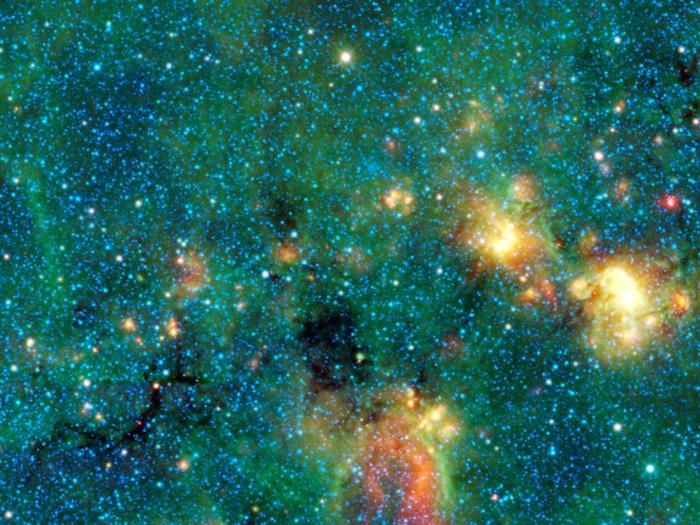
Dark Murky Clouds in the Bright Milky Way
Typically if an astronomer wants to see into or through a thick dark cloud in space, they will use an infrared-sensing telescope. However, in this infrared image from NASA's Wide-field Infrared Survey Explorer, or WISE, there are some clouds that are so cool and thick that even infrared light coming from within or the background can't penetrate them. The black areas in this image -- called infrared dark clouds -- are exceptionally cold, dense cloud cores seen in silhouette against the bright diffuse infrared glow of the plane of the Milky Way galaxy. The clouds are a great example of why it is so useful for astronomers to be able to observe in many different wavelengths of light.
If you were to look at this same region of the sky through a backyard telescope, you would see a sea of stars packed together, similar to the thousands of blue stars seen here. You might also notice small patches of darkness that appear to block out the stars behind them. But what you wouldn't see are these beautiful clouds colored green, yellow and red in this image from WISE. Those are only seen in infrared light. In fact, the places where you see dark patches with your eyes are often the places where WISE sees bright clouds with its infrared "eyes." This is because those clouds are dense enough to block visible light, but not dense enough to block longer wavelengths of infrared light that WISE detects. In addition, they are too cool to shine in visible light but still warm enough to glow brightly in infrared light.
However, the darkest areas here are places where the cloud is extremely compact and chilly, so much so that it is opaque even in the infrared wavelengths that WISE sees. To see them glow, one would need to look in even longer wavelengths, for example those detected by the European Space Agency's Herschel mission, which has important NASA contributions
These dark clouds are so dense that if you were located in the middle of one of them, you wouldn't be able to see anything--no stars, no galaxies, only darkness. This dense material will eventually result in the formation of new stars and planets.
This image was made from observations by all four infrared detectors aboard WISE. Blue and cyan (blue-green) represent infrared light at wavelengths of 3.4 and 4.6 microns, which is primarily light from stars. Green and red represent light at 12 and 22 microns, which is primarily light from warm dust.
JPL manages the Wide-field Infrared Survey Explorer for NASA's Science Mission Directorate, Washington. The principal investigator, Edward Wright, is at UCLA. The mission was competitively selected under NASA's Explorers Program managed by the Goddard Space Flight Center, Greenbelt, Md. The science instrument was built by the Space Dynamics Laboratory, Logan, Utah, and the spacecraft was built by Ball Aerospace & Technologies Corp., Boulder, Colo. Science operations and data processing take place at the Infrared Processing and Analysis Center at the California Institute of Technology in Pasadena. Caltech manages JPL for NASA.
.
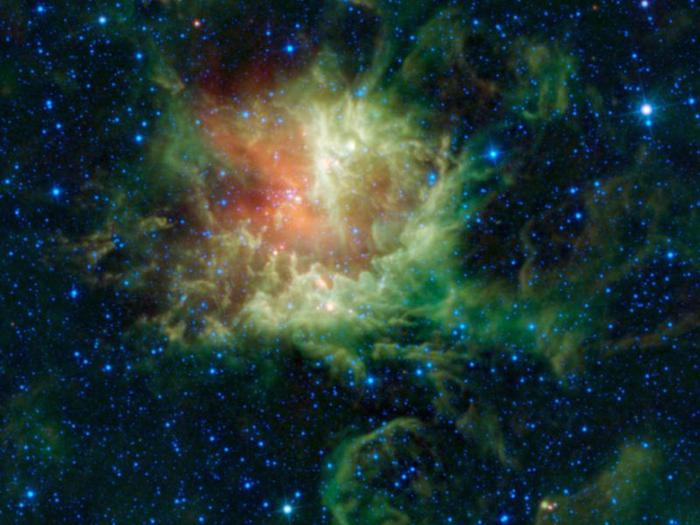
Does 'Pacman' have Teeth?
In visible light, the star-forming cloud catalogued as NGC 281 in the constellation of Cassiopeia appears to be chomping through the cosmos, earning it the nickname the "Pacman" nebula after the famous Pac-Man video game of the 1980s. However, the Wide-field Infrared Survey Explorer, or WISE, observed the nebula in infrared light, revealing a different view.
NGC 281 is a giant cloud of dust and gas located about 9,200 light-years away within our own Milky Way galaxy, and spans about 130 light-years in space. Inside the cloud, a new cluster of stars is forming. This young cluster, called IC 1590, appears as a group of stars near the center of the red and green cloud in the upper portion of the image. Within the cluster there are several very massive stars, many times the mass of the sun. These stars are also very hot and produce large amounts of ultraviolet radiation and blow strong winds. The radiation and winds erode the larger cloud from the inside out, giving it a shell-like appearance. The winds and radiation heat the dust in the cloud, which then glows in infrared light. The wavelengths at which the dust glows depends on the temperatures.
The process of the erosion of the nebula by the young star cluster is thought to trigger the additional formation of stars. Around the edges of NGC 281 are many long columns pointing toward the central star cluster, giving the appearance of the Pac-man with teeth. These are parts of the cloud that are a bit more dense, and hence erode more slowly than the rest of the cloud. At the tips of these columns, the material may be compressed enough to set off the formation of new stars. Also, sprinkled around the images are several star-like objects that appear very red. These are likely baby stars in the early stages of formation. They are wrapped in cocoons of dust, which glow strongly in the longer wavelengths, giving them their red color in this image.
This image was made from observations by all four infrared detectors aboard WISE. Blue and cyan (blue-green) represent infrared light at wavelengths of 3.4 and 4.6 microns, which is primarily from stars, the hottest objects pictured. Green and red represent light at 12 and 22 microns, which is primarily from warm dust (with the green dust being warmer than the red dust).
Image credit: NASA/JPL-Caltech/UCLA
.
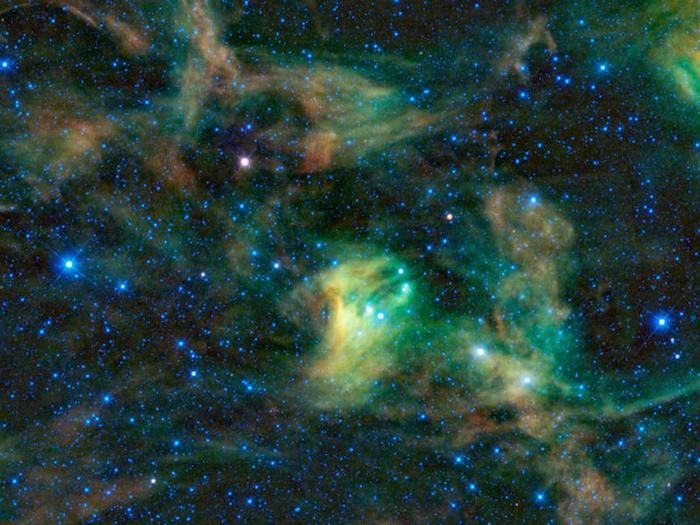
Dusty Reflections in the Scorpion's Claws
Between the claws of the dreaded scorpion imagined by the ancient Greeks lies this giant dust cloud, imaged by the Wide-field Infrared Survey Explorer, or WISE. The constellation of Scorpius is prominent in the summer night sky in North America. In visible light, this cloud, or nebula, appears dark with a ghostly blue shine about it. These types of nebulae are called "reflection," because they are reflecting the light of nearby stars. The dust within the cloud reflects mostly blue light.
However, WISE sees infrared light invisible to the eye. In infrared light, we can see the dust itself glowing rather than simply reflecting light. The green and red colors in this image show dust at different temperatures, with the green dust being warmer than the red dust. The dust is warmed by the light of nearby stars. This interstellar dust contains the heavy elements that planets are made of, and plays a major role in the creation of new stars.
The nebula, known as IC 4601, is part of a larger complex of clouds where new stars are being born. Some of the red stars in this image may in fact be baby stars wrapped in blankets of dust. Perhaps the dreaded scorpion can be thought of as rocking the baby stars to sleep.
This image was made from observations by all four infrared detectors aboard WISE. Blue and cyan (blue-green) represent infrared light at wavelengths of 3.4 and 4.6 microns, which is primarily from stars, the hottest objects pictured. Green and red represent light at 12 and 22 microns, which is primarily from warm dust.
Image credit: NASA/JPL-Caltech/UCLA
Quelle: NASA4790 Views
